Gamification of Learning Process: Applications and Benefits Analysis
VerifiedAdded on 2022/09/05
|8
|1488
|62
Homework Assignment
AI Summary
This paper delves into the concept of gamification in education, exploring its meaning and practical applications. It presents three examples of gamification principles, including classroom themes, avatar creation, and reward systems, highlighting how these methods enhance student engagement and motivation. The paper further discusses the benefits of gamification, such as increased student interest and improved teaching experiences, particularly in online learning environments. It emphasizes how gamification can foster interactive and efficient learning through virtual platforms, ultimately leading to improved student participation and knowledge retention. The conclusion underscores the importance of gamification in actively involving students in the learning process and its positive impact on their ability to utilize acquired knowledge.
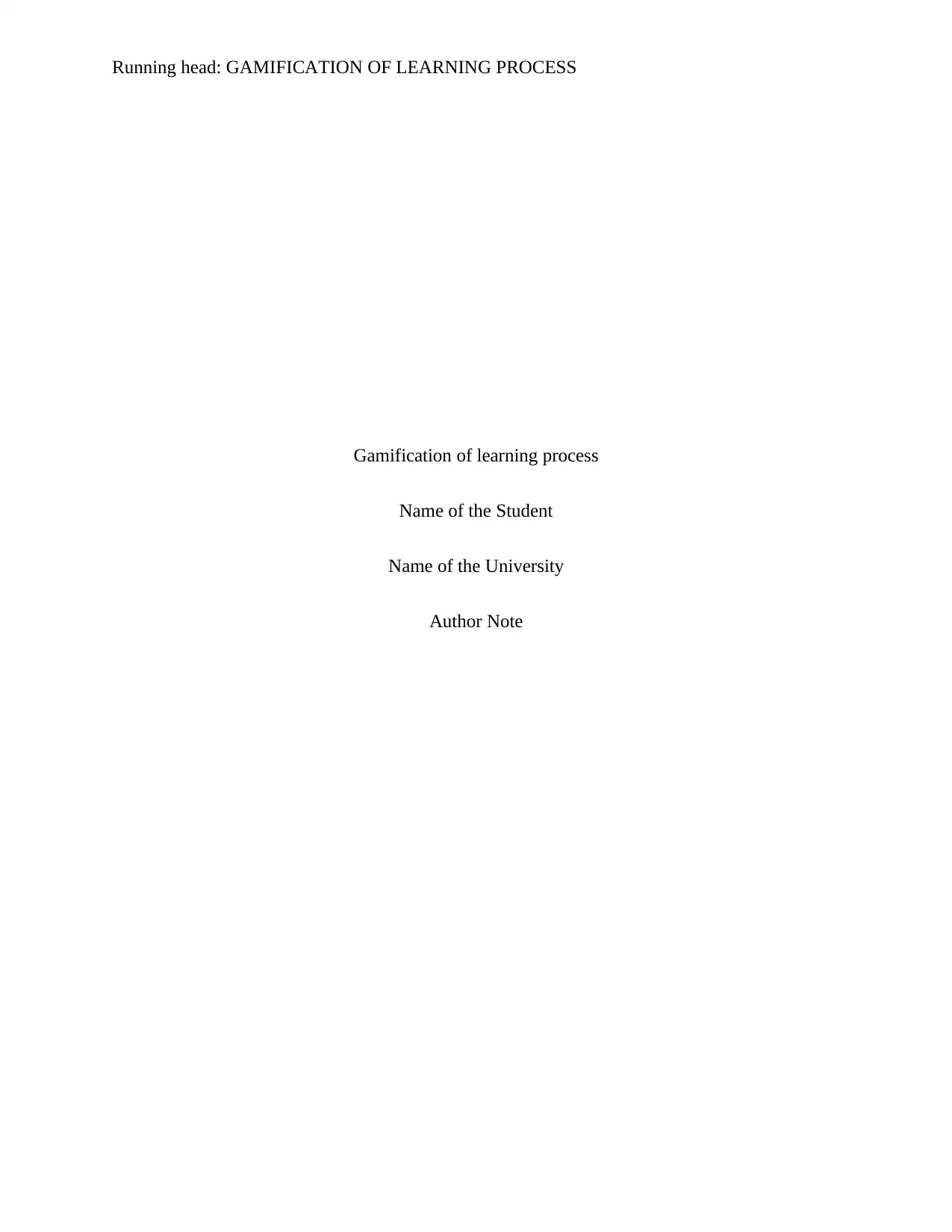
Running head: GAMIFICATION OF LEARNING PROCESS
Gamification of learning process
Name of the Student
Name of the University
Author Note
Gamification of learning process
Name of the Student
Name of the University
Author Note
Paraphrase This Document
Need a fresh take? Get an instant paraphrase of this document with our AI Paraphraser
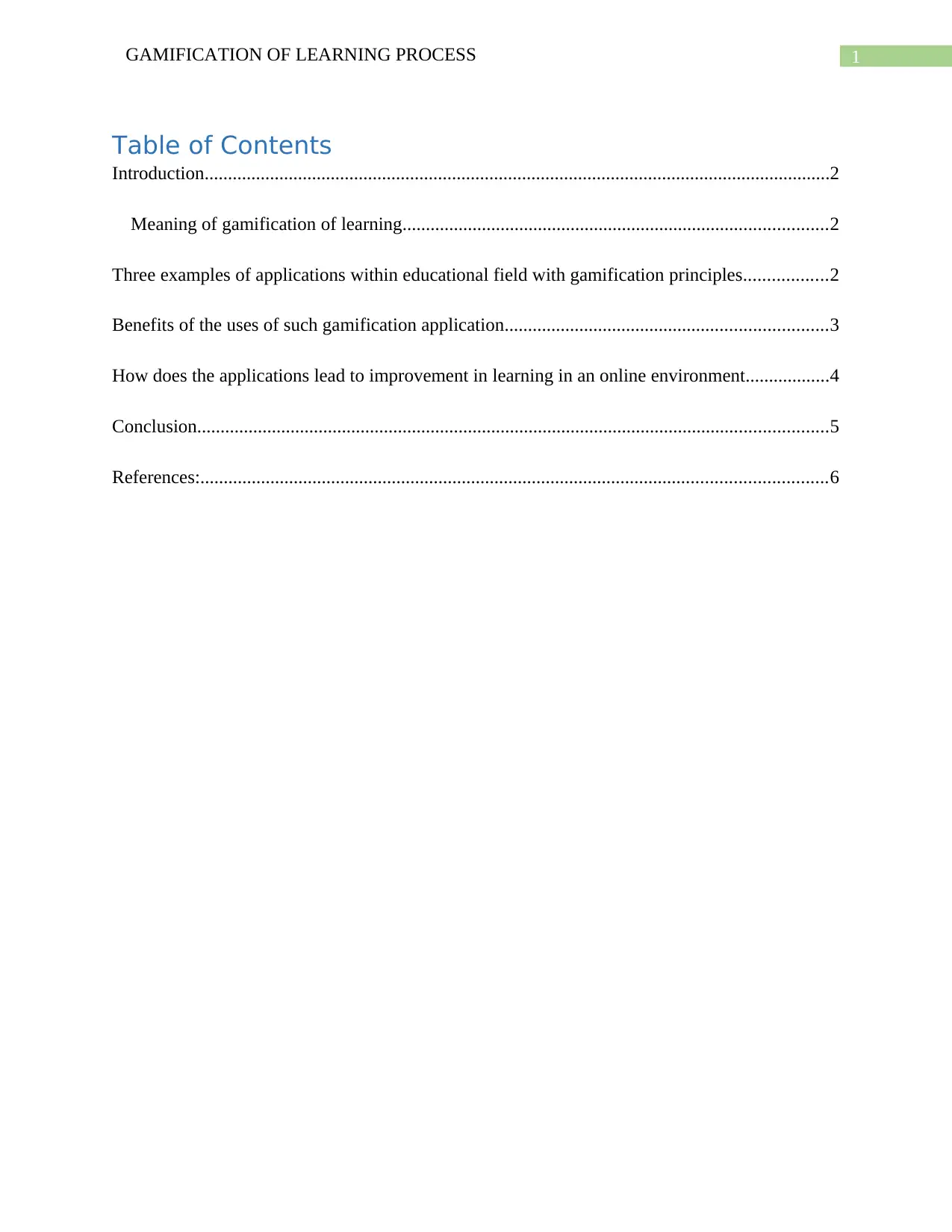
1GAMIFICATION OF LEARNING PROCESS
Table of Contents
Introduction......................................................................................................................................2
Meaning of gamification of learning...........................................................................................2
Three examples of applications within educational field with gamification principles..................2
Benefits of the uses of such gamification application.....................................................................3
How does the applications lead to improvement in learning in an online environment..................4
Conclusion.......................................................................................................................................5
References:......................................................................................................................................6
Table of Contents
Introduction......................................................................................................................................2
Meaning of gamification of learning...........................................................................................2
Three examples of applications within educational field with gamification principles..................2
Benefits of the uses of such gamification application.....................................................................3
How does the applications lead to improvement in learning in an online environment..................4
Conclusion.......................................................................................................................................5
References:......................................................................................................................................6
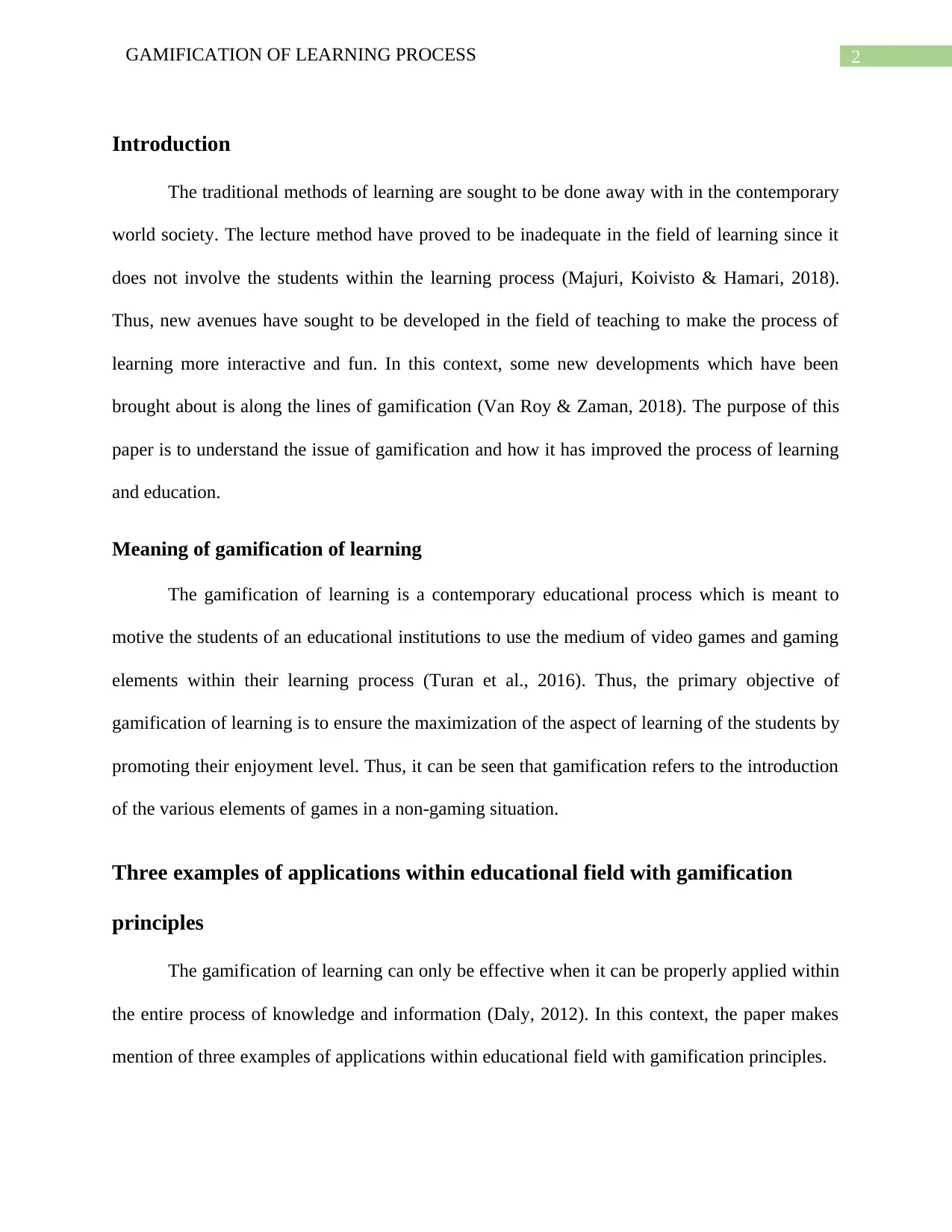
2GAMIFICATION OF LEARNING PROCESS
Introduction
The traditional methods of learning are sought to be done away with in the contemporary
world society. The lecture method have proved to be inadequate in the field of learning since it
does not involve the students within the learning process (Majuri, Koivisto & Hamari, 2018).
Thus, new avenues have sought to be developed in the field of teaching to make the process of
learning more interactive and fun. In this context, some new developments which have been
brought about is along the lines of gamification (Van Roy & Zaman, 2018). The purpose of this
paper is to understand the issue of gamification and how it has improved the process of learning
and education.
Meaning of gamification of learning
The gamification of learning is a contemporary educational process which is meant to
motive the students of an educational institutions to use the medium of video games and gaming
elements within their learning process (Turan et al., 2016). Thus, the primary objective of
gamification of learning is to ensure the maximization of the aspect of learning of the students by
promoting their enjoyment level. Thus, it can be seen that gamification refers to the introduction
of the various elements of games in a non-gaming situation.
Three examples of applications within educational field with gamification
principles
The gamification of learning can only be effective when it can be properly applied within
the entire process of knowledge and information (Daly, 2012). In this context, the paper makes
mention of three examples of applications within educational field with gamification principles.
Introduction
The traditional methods of learning are sought to be done away with in the contemporary
world society. The lecture method have proved to be inadequate in the field of learning since it
does not involve the students within the learning process (Majuri, Koivisto & Hamari, 2018).
Thus, new avenues have sought to be developed in the field of teaching to make the process of
learning more interactive and fun. In this context, some new developments which have been
brought about is along the lines of gamification (Van Roy & Zaman, 2018). The purpose of this
paper is to understand the issue of gamification and how it has improved the process of learning
and education.
Meaning of gamification of learning
The gamification of learning is a contemporary educational process which is meant to
motive the students of an educational institutions to use the medium of video games and gaming
elements within their learning process (Turan et al., 2016). Thus, the primary objective of
gamification of learning is to ensure the maximization of the aspect of learning of the students by
promoting their enjoyment level. Thus, it can be seen that gamification refers to the introduction
of the various elements of games in a non-gaming situation.
Three examples of applications within educational field with gamification
principles
The gamification of learning can only be effective when it can be properly applied within
the entire process of knowledge and information (Daly, 2012). In this context, the paper makes
mention of three examples of applications within educational field with gamification principles.
⊘ This is a preview!⊘
Do you want full access?
Subscribe today to unlock all pages.

Trusted by 1+ million students worldwide
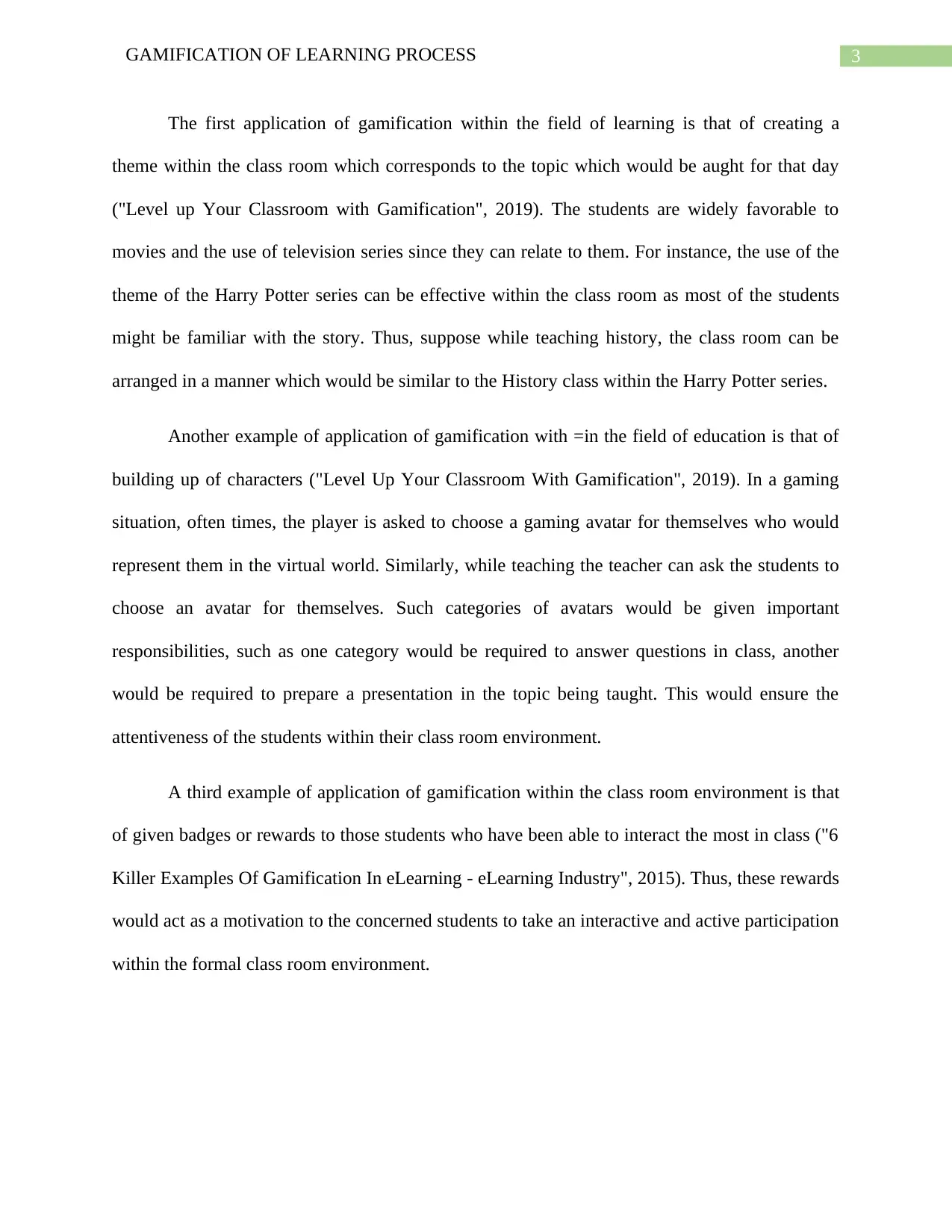
3GAMIFICATION OF LEARNING PROCESS
The first application of gamification within the field of learning is that of creating a
theme within the class room which corresponds to the topic which would be aught for that day
("Level up Your Classroom with Gamification", 2019). The students are widely favorable to
movies and the use of television series since they can relate to them. For instance, the use of the
theme of the Harry Potter series can be effective within the class room as most of the students
might be familiar with the story. Thus, suppose while teaching history, the class room can be
arranged in a manner which would be similar to the History class within the Harry Potter series.
Another example of application of gamification with =in the field of education is that of
building up of characters ("Level Up Your Classroom With Gamification", 2019). In a gaming
situation, often times, the player is asked to choose a gaming avatar for themselves who would
represent them in the virtual world. Similarly, while teaching the teacher can ask the students to
choose an avatar for themselves. Such categories of avatars would be given important
responsibilities, such as one category would be required to answer questions in class, another
would be required to prepare a presentation in the topic being taught. This would ensure the
attentiveness of the students within their class room environment.
A third example of application of gamification within the class room environment is that
of given badges or rewards to those students who have been able to interact the most in class ("6
Killer Examples Of Gamification In eLearning - eLearning Industry", 2015). Thus, these rewards
would act as a motivation to the concerned students to take an interactive and active participation
within the formal class room environment.
The first application of gamification within the field of learning is that of creating a
theme within the class room which corresponds to the topic which would be aught for that day
("Level up Your Classroom with Gamification", 2019). The students are widely favorable to
movies and the use of television series since they can relate to them. For instance, the use of the
theme of the Harry Potter series can be effective within the class room as most of the students
might be familiar with the story. Thus, suppose while teaching history, the class room can be
arranged in a manner which would be similar to the History class within the Harry Potter series.
Another example of application of gamification with =in the field of education is that of
building up of characters ("Level Up Your Classroom With Gamification", 2019). In a gaming
situation, often times, the player is asked to choose a gaming avatar for themselves who would
represent them in the virtual world. Similarly, while teaching the teacher can ask the students to
choose an avatar for themselves. Such categories of avatars would be given important
responsibilities, such as one category would be required to answer questions in class, another
would be required to prepare a presentation in the topic being taught. This would ensure the
attentiveness of the students within their class room environment.
A third example of application of gamification within the class room environment is that
of given badges or rewards to those students who have been able to interact the most in class ("6
Killer Examples Of Gamification In eLearning - eLearning Industry", 2015). Thus, these rewards
would act as a motivation to the concerned students to take an interactive and active participation
within the formal class room environment.
Paraphrase This Document
Need a fresh take? Get an instant paraphrase of this document with our AI Paraphraser
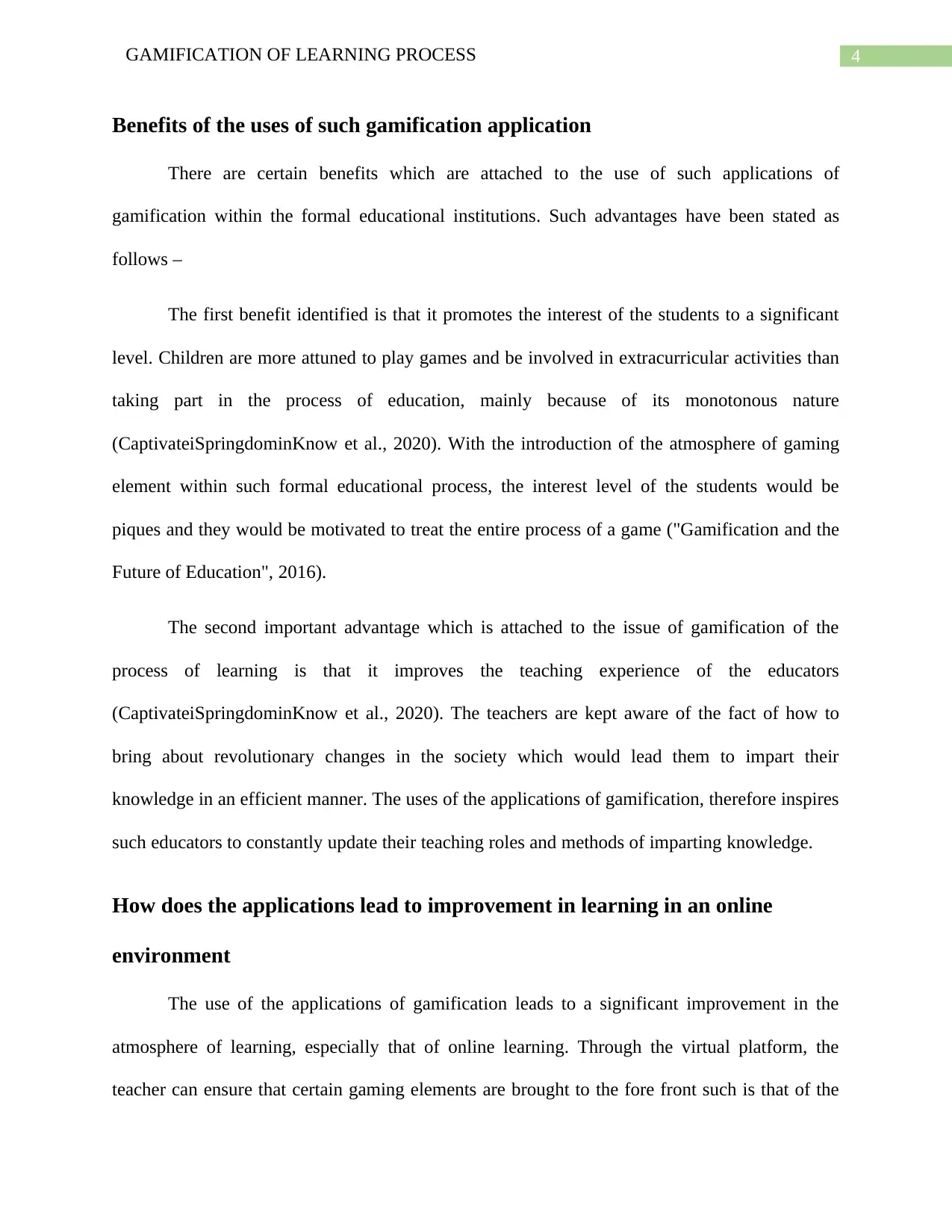
4GAMIFICATION OF LEARNING PROCESS
Benefits of the uses of such gamification application
There are certain benefits which are attached to the use of such applications of
gamification within the formal educational institutions. Such advantages have been stated as
follows –
The first benefit identified is that it promotes the interest of the students to a significant
level. Children are more attuned to play games and be involved in extracurricular activities than
taking part in the process of education, mainly because of its monotonous nature
(CaptivateiSpringdominKnow et al., 2020). With the introduction of the atmosphere of gaming
element within such formal educational process, the interest level of the students would be
piques and they would be motivated to treat the entire process of a game ("Gamification and the
Future of Education", 2016).
The second important advantage which is attached to the issue of gamification of the
process of learning is that it improves the teaching experience of the educators
(CaptivateiSpringdominKnow et al., 2020). The teachers are kept aware of the fact of how to
bring about revolutionary changes in the society which would lead them to impart their
knowledge in an efficient manner. The uses of the applications of gamification, therefore inspires
such educators to constantly update their teaching roles and methods of imparting knowledge.
How does the applications lead to improvement in learning in an online
environment
The use of the applications of gamification leads to a significant improvement in the
atmosphere of learning, especially that of online learning. Through the virtual platform, the
teacher can ensure that certain gaming elements are brought to the fore front such is that of the
Benefits of the uses of such gamification application
There are certain benefits which are attached to the use of such applications of
gamification within the formal educational institutions. Such advantages have been stated as
follows –
The first benefit identified is that it promotes the interest of the students to a significant
level. Children are more attuned to play games and be involved in extracurricular activities than
taking part in the process of education, mainly because of its monotonous nature
(CaptivateiSpringdominKnow et al., 2020). With the introduction of the atmosphere of gaming
element within such formal educational process, the interest level of the students would be
piques and they would be motivated to treat the entire process of a game ("Gamification and the
Future of Education", 2016).
The second important advantage which is attached to the issue of gamification of the
process of learning is that it improves the teaching experience of the educators
(CaptivateiSpringdominKnow et al., 2020). The teachers are kept aware of the fact of how to
bring about revolutionary changes in the society which would lead them to impart their
knowledge in an efficient manner. The uses of the applications of gamification, therefore inspires
such educators to constantly update their teaching roles and methods of imparting knowledge.
How does the applications lead to improvement in learning in an online
environment
The use of the applications of gamification leads to a significant improvement in the
atmosphere of learning, especially that of online learning. Through the virtual platform, the
teacher can ensure that certain gaming elements are brought to the fore front such is that of the
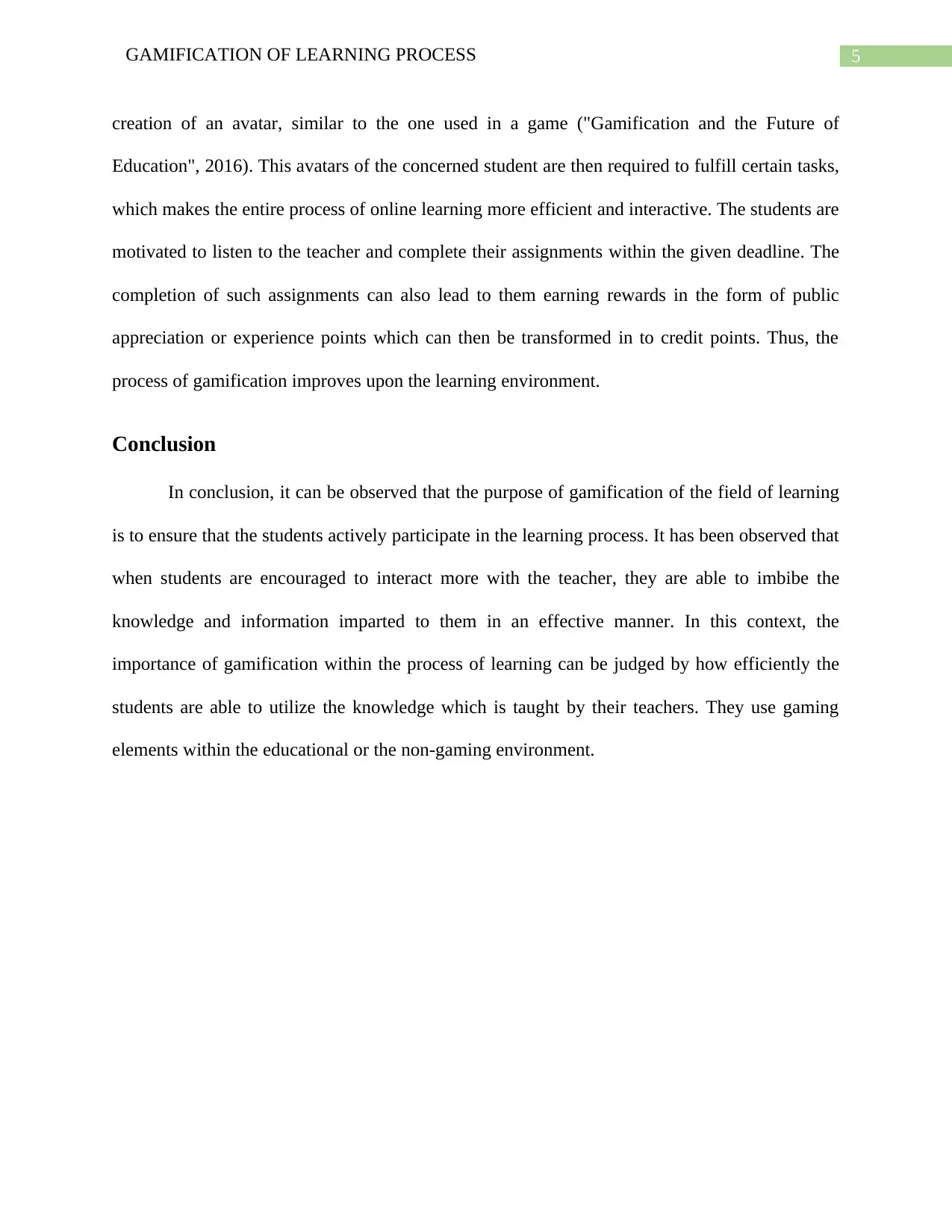
5GAMIFICATION OF LEARNING PROCESS
creation of an avatar, similar to the one used in a game ("Gamification and the Future of
Education", 2016). This avatars of the concerned student are then required to fulfill certain tasks,
which makes the entire process of online learning more efficient and interactive. The students are
motivated to listen to the teacher and complete their assignments within the given deadline. The
completion of such assignments can also lead to them earning rewards in the form of public
appreciation or experience points which can then be transformed in to credit points. Thus, the
process of gamification improves upon the learning environment.
Conclusion
In conclusion, it can be observed that the purpose of gamification of the field of learning
is to ensure that the students actively participate in the learning process. It has been observed that
when students are encouraged to interact more with the teacher, they are able to imbibe the
knowledge and information imparted to them in an effective manner. In this context, the
importance of gamification within the process of learning can be judged by how efficiently the
students are able to utilize the knowledge which is taught by their teachers. They use gaming
elements within the educational or the non-gaming environment.
creation of an avatar, similar to the one used in a game ("Gamification and the Future of
Education", 2016). This avatars of the concerned student are then required to fulfill certain tasks,
which makes the entire process of online learning more efficient and interactive. The students are
motivated to listen to the teacher and complete their assignments within the given deadline. The
completion of such assignments can also lead to them earning rewards in the form of public
appreciation or experience points which can then be transformed in to credit points. Thus, the
process of gamification improves upon the learning environment.
Conclusion
In conclusion, it can be observed that the purpose of gamification of the field of learning
is to ensure that the students actively participate in the learning process. It has been observed that
when students are encouraged to interact more with the teacher, they are able to imbibe the
knowledge and information imparted to them in an effective manner. In this context, the
importance of gamification within the process of learning can be judged by how efficiently the
students are able to utilize the knowledge which is taught by their teachers. They use gaming
elements within the educational or the non-gaming environment.
⊘ This is a preview!⊘
Do you want full access?
Subscribe today to unlock all pages.

Trusted by 1+ million students worldwide
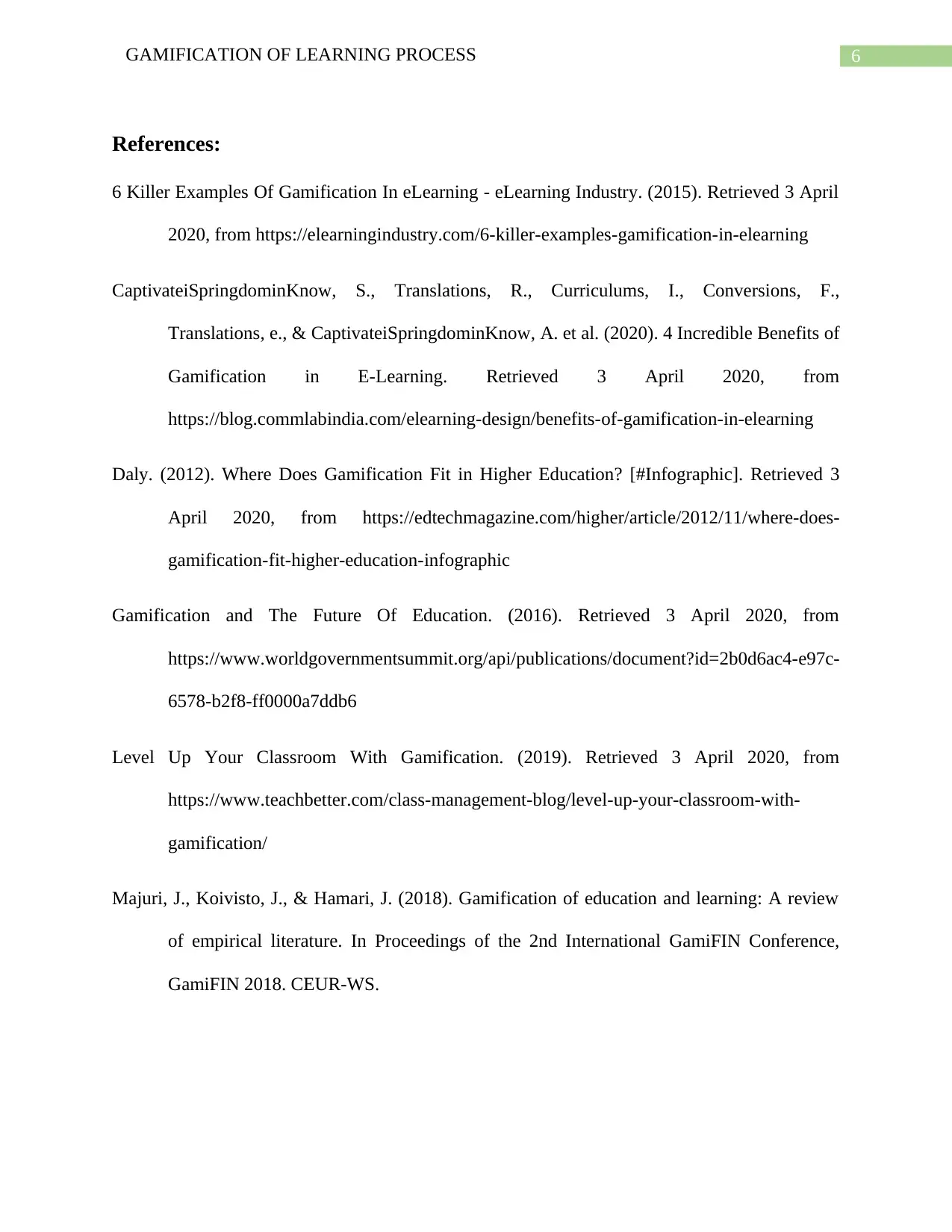
6GAMIFICATION OF LEARNING PROCESS
References:
6 Killer Examples Of Gamification In eLearning - eLearning Industry. (2015). Retrieved 3 April
2020, from https://elearningindustry.com/6-killer-examples-gamification-in-elearning
CaptivateiSpringdominKnow, S., Translations, R., Curriculums, I., Conversions, F.,
Translations, e., & CaptivateiSpringdominKnow, A. et al. (2020). 4 Incredible Benefits of
Gamification in E-Learning. Retrieved 3 April 2020, from
https://blog.commlabindia.com/elearning-design/benefits-of-gamification-in-elearning
Daly. (2012). Where Does Gamification Fit in Higher Education? [#Infographic]. Retrieved 3
April 2020, from https://edtechmagazine.com/higher/article/2012/11/where-does-
gamification-fit-higher-education-infographic
Gamification and The Future Of Education. (2016). Retrieved 3 April 2020, from
https://www.worldgovernmentsummit.org/api/publications/document?id=2b0d6ac4-e97c-
6578-b2f8-ff0000a7ddb6
Level Up Your Classroom With Gamification. (2019). Retrieved 3 April 2020, from
https://www.teachbetter.com/class-management-blog/level-up-your-classroom-with-
gamification/
Majuri, J., Koivisto, J., & Hamari, J. (2018). Gamification of education and learning: A review
of empirical literature. In Proceedings of the 2nd International GamiFIN Conference,
GamiFIN 2018. CEUR-WS.
References:
6 Killer Examples Of Gamification In eLearning - eLearning Industry. (2015). Retrieved 3 April
2020, from https://elearningindustry.com/6-killer-examples-gamification-in-elearning
CaptivateiSpringdominKnow, S., Translations, R., Curriculums, I., Conversions, F.,
Translations, e., & CaptivateiSpringdominKnow, A. et al. (2020). 4 Incredible Benefits of
Gamification in E-Learning. Retrieved 3 April 2020, from
https://blog.commlabindia.com/elearning-design/benefits-of-gamification-in-elearning
Daly. (2012). Where Does Gamification Fit in Higher Education? [#Infographic]. Retrieved 3
April 2020, from https://edtechmagazine.com/higher/article/2012/11/where-does-
gamification-fit-higher-education-infographic
Gamification and The Future Of Education. (2016). Retrieved 3 April 2020, from
https://www.worldgovernmentsummit.org/api/publications/document?id=2b0d6ac4-e97c-
6578-b2f8-ff0000a7ddb6
Level Up Your Classroom With Gamification. (2019). Retrieved 3 April 2020, from
https://www.teachbetter.com/class-management-blog/level-up-your-classroom-with-
gamification/
Majuri, J., Koivisto, J., & Hamari, J. (2018). Gamification of education and learning: A review
of empirical literature. In Proceedings of the 2nd International GamiFIN Conference,
GamiFIN 2018. CEUR-WS.
Paraphrase This Document
Need a fresh take? Get an instant paraphrase of this document with our AI Paraphraser
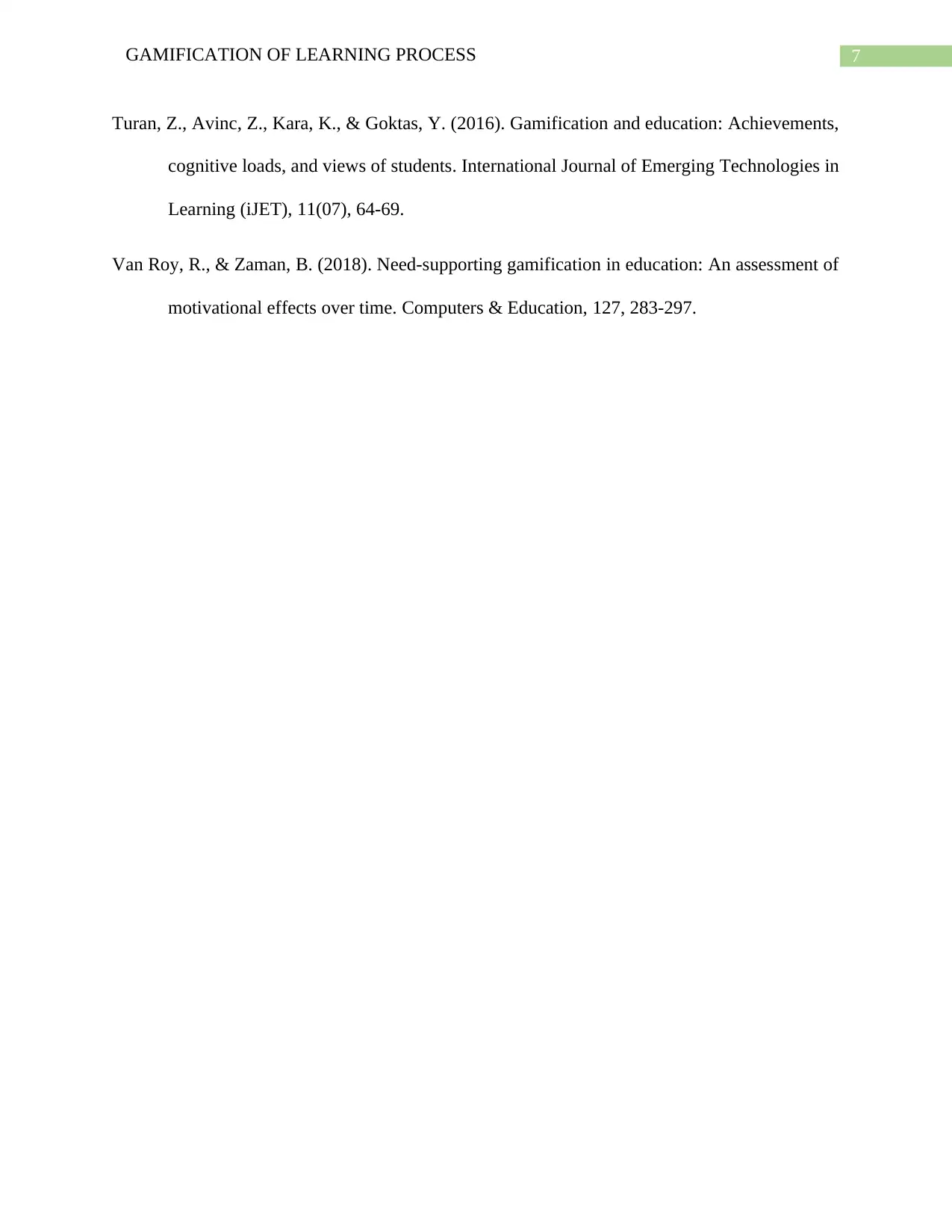
7GAMIFICATION OF LEARNING PROCESS
Turan, Z., Avinc, Z., Kara, K., & Goktas, Y. (2016). Gamification and education: Achievements,
cognitive loads, and views of students. International Journal of Emerging Technologies in
Learning (iJET), 11(07), 64-69.
Van Roy, R., & Zaman, B. (2018). Need-supporting gamification in education: An assessment of
motivational effects over time. Computers & Education, 127, 283-297.
Turan, Z., Avinc, Z., Kara, K., & Goktas, Y. (2016). Gamification and education: Achievements,
cognitive loads, and views of students. International Journal of Emerging Technologies in
Learning (iJET), 11(07), 64-69.
Van Roy, R., & Zaman, B. (2018). Need-supporting gamification in education: An assessment of
motivational effects over time. Computers & Education, 127, 283-297.
1 out of 8
Related Documents
Your All-in-One AI-Powered Toolkit for Academic Success.
+13062052269
info@desklib.com
Available 24*7 on WhatsApp / Email
![[object Object]](/_next/static/media/star-bottom.7253800d.svg)
Unlock your academic potential
Copyright © 2020–2025 A2Z Services. All Rights Reserved. Developed and managed by ZUCOL.





